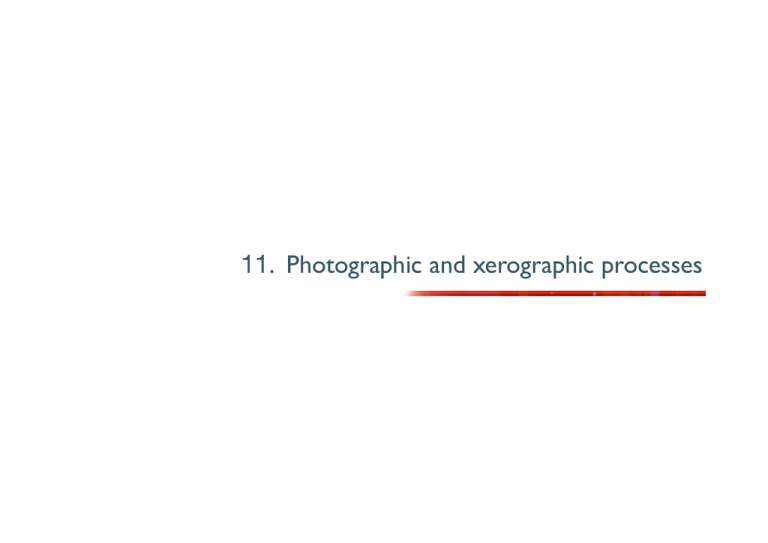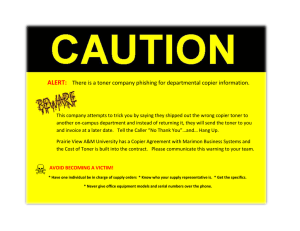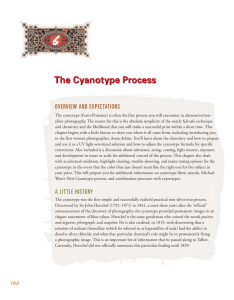11. Photographic and xerographic processes
advertisement

11. Photographic and xerographic processes Introduction Optical signal Molecular sensor Photoconductor sensor Chemical signal Electrical signal Visualization Visualization SC / PC Scanning readout Photographic systems Photochemical systems Steps: Electrophotography Electronic systems 1. Light exposure (photochemical reaction, formation of a latent image) 2. Image development (amplified or non-amplified visualization process) 3. Image fixing (removal of the actinic compound 133 11.1 Molecular systems Blueprints (cyanotype) First developed in 1842 by british scientist James Herschel, blueprinting uses a wet process to produce an image of white lines on a cyan ground. Paper is impregnated with K3[FeIII(CN)6] and ferric ammonium citrate, placed under a translucent original and exposed to ultraviolet light. After light exposure, the blueprint paper is washed with water to reveal a negative image, the blue color of which is due to the formation of the Prussian blue pigment FeIII4FeII3(CN)18(xH2O). The same process, using an intermediary negative print on translucent substrate, could also be used to produce a positive blueprint. Cyanotype was a popular process for amateur photographers in the late 19th and early 20th century because it required very minimal equipment and facilities. [FeIII(CN)6]3– + ammonium citrate 4 Fe3+ + 3 [FeII(CN)6]4– + x H2O hν Direct contact cyanotype of a fern species (Anna Atkins, 1845) Mirror portrait (ca 1890) [FeII(CN)6]4– + products FeIII4FeII3(CN)18· (H2O)14-18 (Prussian blue) 134 Diazo printing In the early 1940s, cyanotype blueprints began to be supplanted by diazo prints (or 'whiteprints'), which allow for positive imaging (dark image on white background). Diazo prints remained in use for construction plans reprography until they were progressively replaced by xerography and digital printing at the end of the 20th century. The image-recording technique is based on the UV photolysis of substituted aryl-diazonium salts: N N+ OH + h! H2O + H+ – N2 R R R N N Et N+ N N N+ Et RO N O MeO N+ N OR R = Et, Bu 135 Diazo printing Exposure to UV light of a diazonium salt coated on a substrate within a polymeric binder leads to the destruction of the actinic compound. The coupling of unexposed diazonium salt to get photostable azo-dyes is utilized for the visualization of the image: OH N R NH3 N+ N + – H+ R R' R N N R N OH azo-dye (stable) R' azo-coupler R' X–CH2COOR R' OH O yellow brown OH OH H2C N N Ar red CONHAr blue The azo-coupling proceeds via base catalysis. The development is generally carried out in a wet NH3 atmosphere under pressure. A positive image is obtained. There is no stabilization step (image fixing), since the actinic layer is destroyed by light or by azo-coupling. Diazo printing sensitivity is rather low (non-amplified development system). The rendering of details is however outstanding and allows the duplication of microfilms. The maximum resolution attainable is R = 2,000 mm–1 (5,000 dpi). As well, information storage density up to Cis = 3· 1010 bit/ cm2 can be achieved by this monochromatic process. 136 Other photo-induced dye-formation systems Photochromic systems are distinguished by the reversible change of the absorption behavior in the visible-UV range, with at least one of the two states A or B having to absorb in the visble range of the spectrum. –O UV UV N O NO2 benzospiropyran ⇌ hν' or ∇ B Because of this reversibility, photochromic systems have been investigated for a long time with respect to their application as erasable image and data memories. One of the most famous application, however, is color-changing lenses for sunglasses. Three examples are provided here. The number of cycles nc is defined as the number of exposures at which the optical read-out density is decreased by half. O O UV UV O O indoylfulgide E form E NO2 merocyanine nc = 102 O hν A N+ vis vis vis vis O O O C form nc = 103 e– e– vis UV FeIII/FeII h+ Fe3+-doped SrTiO3 FeIII/FeII h+ nc = 106 137 11.2 Photopolymer systems for image recording Photopolymers usually contain a mixture of binders, polymer, monomer, photoinitiators and sensitizers. Upon light exposure and subsequent polymerization or cross-linking of the photoresist, the volume of the material tends to decrease. This densification usually involves an increase of the real part of the refractive index n of the exposed areas. Fixing of the image can be achieved by removal of the unexposed resist by differential solubility in a solvent. This last step yields a 3D photo-lithographic structure. photoresist substrate exposure hν washing negative positive Alternatively, light exposure can degrade a pre-existing polymer present in the resist. The irradiated material tends in this case to have decreased refractive index and to become more soluble. Development by washing with a solvent will then yield a positive image (no resist left on exposed areas). Because positive photoresist images are difficult to fix (requires hardbaking or other chemical treatments), negative imaging is usually preferred for image recording photopolymer systems. 138 Photolithographic offset printing hydrophobic photopolymer 1. 2. hydrophillic Al2O3 oily ink water film rubber-blanketed roller 3. ink transfer to offset cylinder 4. 5. ink transfer to paper (offset printing) 6. paper The offset printing plate is usually made of aluminum, with the surface anodized to render it porous and then coated with a photosensitive material. Exposure to an image photocures the coating on printing areas; the coating on nonprinting areas is washed away, leaving wetted hydrophillic metal oxide that will reject oily ink. 139 Holographic recording Photopolymers such as PMMA or α-cyanaoacrylates exhibit large refractive index changes upon photocrosslinking when exposed to low power laser beams. When the optical excitation consists of two interfering coherent beams, the periodic light distribution produces a periodic refractive index modulation. The resulting index change produces a hologram in the volume of the polymer film. The hologram can be reconstructed by diffracting a third laser beam on the periodic index modulation. Photopolymer plate Photopolymer plate 1. Recording 2.Viewing Viewer 140 Photorefractive polymers 1. Image writing In contrast to the curing of photoresists to generate a permanent refractive index change, some semiconducting polymers are subjected to a fully reversible photorefractive effect, meaning that the recorded image can be erased with a spatially uniform light beam. This reversibility makes photorefractive polymers suitable for real-time holographic applications. The mechanism that leads to the formation of a photorefractive index modulation involves the formation of an internal electric field through the absorption of light, the generation of carriers, their transport and trapping over macroscopic distances. E irradiated zones or interference fringes e– e– cb hν etr– etr– h+ hν h+ vb impurity donor states electron traps 2. Erasing E cb e– e– hν hν etr– etr– h+ h+ vb 141 11.3 Electrophotography The electrophotographic process, discovered in 1938 by Chester Carlson (USA), ser ves as the foundation for electrostatic copying. 'Xerographic' office photocopying was introduced by Xerox in 1959. The basic process is illustrated here on the right. Electrostatic copying uses a light source to transfer data or images onto charged photoconductive material for printing. This process f o r m s a n e l e c t ro s t a t i c i m a g e (exposure) on the photosensitive material, which is then made visible using toner. Although analogic copiers were using common halogen lamps as a light source, digital electrophotographic imaging (digital photocopiers and 'laser' printers) currently employs LED arrays or semiconductor Lasers. photoconductor paper + – --------+++++++++ 1. corona charge 3. toner transfer --------------- heat ++++++++++++++ 2. light exposure metal 4. toner fusing Photoconductors materials a-Se Se-Te-alloys ZnO Dye-sensitized ZnO CdS Organic solid λmax = 400-600 nm 860 nm 385 nm 700 nm 850 nm 400-850 nm 142 Electrophotography Laser printhead charger toner photoreceptor drum Erase (discharge and clean) fixing unit fuser cylinder press cylinder Colored toner (dry polymer spheres or colloidal dispersions in an organic solvent) became available in the 1950s, although the first electrostatic color copier was released by Canon in 1973. Color images are generally obtained by the superposition of 4 distinct images produced consecutively on the same photoreceptor drum with 4 different colored toner (yellow, magenta, cyan and black). Direct superposition of toner particles is generally difficult, resulting in color patterning and half-toning strategies for color reproduction. paper transfer unit (charger) 143



